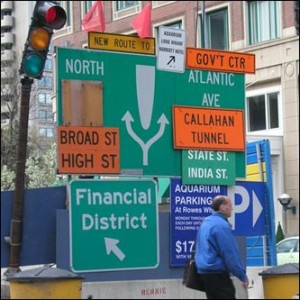
Dear______:
No, I am not kidding. The story of the Old Testament is actually pretty simple. Once you grasp it, all the parts make more sense.
I know, finding your way around can be about as confusing as driving in Boston during construction season:
- The overall timeline is not made clear.
- Once you figure out the timeline, some books are difficult or impossible to place on it.
- Some parts of the story seem more like ancient myth and others more like history–and some big parts aren’t actually stories at all.
- Some stories are told more than once, either within the same book or in two different books.
The real problem, to be frank, is that most people don’t read the Bible cover to cover, or go back and read it again, with an eye to following the plot.
Now, aside from the fact that what you really need to feed your spiritual life is an ongoing practice of regular daily Bible reading and meditation, I want to make it easy for you: I’m going to tell you what the outline is.
The Story of the Old Testament
I don’t actually have much time to write today so I’ll be quick. Just the high points:
1. God creates the world good.
2. People make a mess of their lives.
3. God calls one family from all the peoples of the world, to make them his own as the beginning of his work to redeem the world.
4. In a time great famine, that family goes to Egypt to find food, and becomes enslaved there.
Those four points simplify the main parts of the book of Genesis. There’s a lot more to Genesis, a disproportionately large number of important people and events. But remember we’re just looking for the outline.
5. Moses leads them to freedom, through the waters of the Red Sea, and God makes a covenant with the people, giving them the Ten Commandments as his guide to what life as his people looks like. Then they wander in the wilderness.
That one (really at least three, but I’m cheating) is the rest of the Pentateuch Exodus through Deuteronomy.
6. Moses and his generation die in the wilderness, and Joshua leads the people into the promised land where they displace other nations. During this time they have no king, but are led by “Judges”, leaders raised up by God from time to time.
7. The people beg God for a king like the neighboring nations have, so God appoints Saul and then David and then David’s son Solomon.
That’s from Joshua all the way into First Kings.
8. Solomon’s son rules unwisely, and the kingdom is divided: ten tribes in the north called Israel, and two tribes in the South called Judah. But God never gives up, continually sending prophets, who call them back to faithfulness and justice, and bring the promise that God will send a Savior.
9. The northern kingdom of Israel falls to an invading army, never to be restored. Eventually the southern kingdom of Judah also falls, and it’s leaders are taken into exile while the prophets promise restoration.
10. Finally the leaders of Judah return, and they work to restore Jerusalem and the Temple, and wait for the coming of the Messiah.
That’s the rest of Kings and Chronicles.
That’s it really. Your job is to figure out which books, and which parts of books, fit into which parts of the story.
Knowing all the details takes time, but you can manage a ten point outline. (I squeezed it a bit. You could argue that 14 or 15 would be better.)
I’m serious: If you just memorize the ten plot points I listed, you can make sense of the whole Old Testament.
Have fun.
Blessings,
Gary
——
This post is part of a series. To start from the beginning, click here.

Leave a Reply